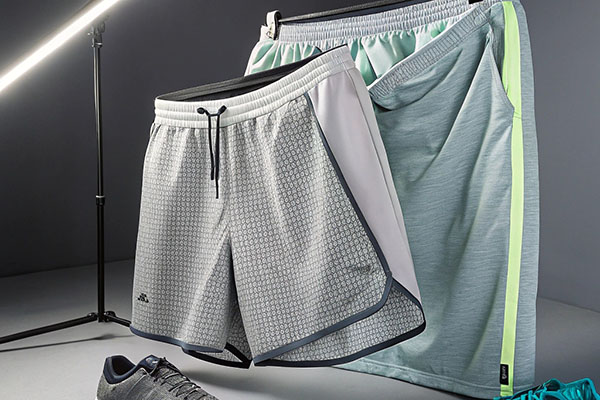If you’ve ever worn athletic shorts, you’ve likely noticed the built-in lining. This feature is more than just an added layer of fabric—it plays a crucial role in enhancing comfort, performance, and functionality during workouts. But why exactly are athletic shorts lined, and what benefits do they offer?
Athletic shorts are lined to provide support, prevent chafing, wick moisture1, and eliminate the need for additional undergarments. The lining enhances the overall comfort and functionality, making the shorts ideal for high-intensity activities.
In this article, we’ll explore the reasons athletic shorts are lined, the types of linings available, and how to choose the best lined shorts for your needs.

Why Do Athletic Shorts Have a Liner?
The lining in athletic shorts is designed to address common issues faced during physical activities. Here are the primary reasons:
1. Enhanced Support
The built-in liner acts as a supportive layer, keeping everything in place during movement.
- Purpose: Provides light compression and prevents discomfort during high-impact activities like running or jumping.
- Ideal For: Activities requiring stability, such as sprinting or aerobics.
2. Chafing Prevention
Chafing is a common issue during prolonged workouts, especially when sweat and friction combine. Linings are designed to minimize this discomfort.
- How It Helps: The smooth fabric of the liner reduces skin-to-skin contact and prevents irritation.
3. Moisture Management
During exercise, sweat can accumulate and cause discomfort. Moisture-wicking1 lined shorts help address this.
- Moisture-Wicking Properties: The liner is typically made from polyester or nylon, which draw sweat away from the skin.
- Quick-Drying: Keeps you feeling dry and comfortable throughout your workout.
4. Convenience and Versatility
Lined athletic shorts eliminate the need for separate undergarments.
- Built-In Solution: The liner acts as both underwear and support, simplifying your workout attire.
- Hygienic: Reduces the number of layers, promoting better airflow and reducing odor buildup.

Types of Linings in Athletic Shorts
Not all linings are created equal. The type of lining can influence comfort, performance, and suitability for specific activities.
1. Brief Liners
What Are They?
Brief liners are snug, short undergarment-style linings found in most running and training shorts.
Features:
- Provide light compression.
- Reduce movement for better stability.
Best For:
- Running, sprinting, and other high-mobility activities.
2. Compression Liners
What Are They?
Compression liners offer more support than traditional briefs, extending down the thighs like compression shorts.
Features:
- Muscle support and reduced fatigue.
- Prevents chafing over long distances.
Best For:
- Long-distance running, cycling, and strength training.
3. Mesh Liners
What Are They?
Mesh liners are lightweight and breathable, commonly found in casual and multi-sport athletic shorts.
Features:
- Excellent ventilation.
- Quick-drying for added comfort.
Best For:
- Hot weather workouts and general training.

Benefits of Lined Athletic Shorts
Here’s why lined shorts outperform their unlined counterparts:
| Feature | Benefit |
|---|---|
| Supportive Fit | Keeps everything in place during movement. |
| Chafing Prevention | Smooth lining reduces skin irritation. |
| Moisture Management | Wicks sweat and keeps you dry. |
| Hygienic Design | Built-in liners reduce the need for undergarments. |
| Lightweight Comfort | Eliminates extra layers for better mobility. |
When to Choose Lined vs. Unlined Shorts
The choice between lined and unlined shorts depends on your activity level and personal preferences.
Lined Shorts
- Best For: High-impact workouts, long-distance running, and hot weather.
- Advantages: Simplifies your gear, prevents chafing, and provides better moisture control.
Unlined Shorts
- Best For: Casual wear, low-intensity activities, or layering with compression shorts.
- Advantages: Greater flexibility to pair with your preferred base layer.
Caring for Lined Athletic Shorts
To maintain the performance of your lined shorts, follow these care tips:
1. Wash in Cold Water
- Check out best practices for washing lined workout shorts2 to protect the moisture-wicking properties and prevent shrinking.
2. Avoid Fabric Softeners
- Softeners can coat the fabric, reducing its ability to wick sweat.
3. Air Dry
- Prolongs the life of the elastic and quick-drying features.
Innovations in Athletic Short Linings
Sportswear brands are constantly improving their designs to maximize performance. Here are some innovations in lined shorts:
1. Antimicrobial Linings
- Antimicrobial treatments in sports apparel3 help prevent odor buildup by reducing bacteria growth.
2. Stretch Technology
- Linings now feature four-way stretch4 for unrestricted movement.
3. Sustainable Materials
- Sustainable athletic gear production5 includes the use of recycled polyester or eco-friendly fabrics for their linings.
Popular Brands for Lined Athletic Shorts
Here are some top brands offering high-quality lined athletic shorts:
- Nike: Known for its Dri-FIT technology, offering moisture-wicking liners.
- Adidas: Features lightweight and breathable mesh linings.
- Lululemon: Offers luxurious compression liners in their running shorts.
- Under Armour: Provides antimicrobial treatments for odor control.
- Patagonia: Focuses on sustainable materials for eco-conscious athletes.
Conclusion
Athletic shorts are lined to enhance comfort, support, and performance during workouts. Whether it’s to prevent chafing, wick away sweat, or eliminate the need for additional undergarments, the lining is an essential feature for activewear. By understanding the benefits of lined shorts and choosing the right type for your activities, you can stay comfortable and focused, no matter how intense your workout gets.
-
Learning sweat-drawing principles aids comfort and dryness during high-intensity workouts. ↩ ↩
-
Preserving shape and performance extends the garment’s useful life and effectiveness. ↩
-
Reducing odor and bacterial growth ensures longer-lasting freshness and hygiene. ↩
-
Understanding advanced fabric elasticity supports greater freedom of movement and flexibility. ↩
-
Exploring eco-friendly materials fosters responsible and environmentally conscious sportswear choices. ↩













